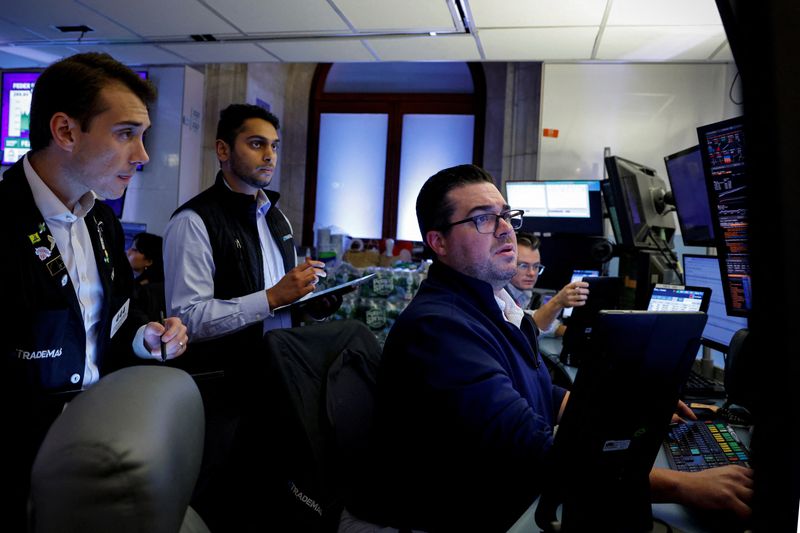By Sinéad Carew and Lisa Pauline Mattackal
(Reuters) -Wall Street’s three major indexes closed down around 1% on Monday while Treasury yields rose, as traders tamped down bets for Federal Reserve interest-rate easing and worried about the Middle East conflict’s impact on oil prices.
While waiting for quarterly earnings season and fresh economic data, investors also braced for another big hurricane, Milton, which is expected to hit the United States this week. Relief efforts are under way after Helene, a Category-4 hurricane, killed more than 200 people across six states.
Further dampening sentiment on Monday was an order from a U.S. judge for market heavyweight Alphabet (NASDAQ:GOOGL)’s Google to overhaul its mobile-app business to give Android phone users more options. Analyst reports also spurred selling of Amazon.com (NASDAQ:AMZN) and Apple Inc (NASDAQ:AAPL).
After Friday’s stronger-than-expected jobs report, traders pulled back from bets for a 50-basis-point rate cut in November. They were pricing in an 86% chance of a 25-basis-point cut and a roughly 14% chance the central bank would not cut rates at all, according to the CME’s FedWatch tool.
The change in rate-cut expectations caused U.S. Treasury yields to rally, with the yield on benchmark 10-year notes exceeding 4% for the first time in two months.
Besides next month’s Fed meeting, investors are waiting for the Consumer Price Index inflation reading for September and the kickoff of third-quarter earnings season with reports from banks, both due this week.
“It’s a combination of things over the last couple of days: the jobs report, the hurricane damage, the elevated energy prices and negative comments about some of the large-cap tech names,” said Michael James, managing director of equity trading at Wedbush Securities in Los Angeles.
“All of that combined just makes for a nervous day, and the Google headlines tipped things over to more aggressive selling in the last hour.”
James pointed to the Middle East conflict as a concern for U.S. investors who are worried about the war’s economic impact, including rising oil prices.
Investors continue to fret about how Israel would respond to Iran’s missile strikes. On Monday, Lebanon’s armed group Hezbollah fired rockets at Israel’s city of Haifa while Israeli forces looked poised to expand ground raids into south Lebanon.
The Dow Jones Industrial Average fell 398.51 points, or 0.94%, to 41,954.24, the S&P 500 lost 55.13 points, or 0.96%, to 5,695.94 and the Nasdaq Composite lost 213.94 points, or 1.18%, to 17,923.90.
The CBOE Volatility index, Wall Street’s fear gauge, closed up 3.4 points at 22.64, marking its biggest one-day points gain in more than a month and its highest closing level since Aug. 8.
Among the S&P 500’s 11 major industry indexes, only energy advanced, finishing up 0.4%. U.S. crude futures settled up 3.7% in their fifth-straight advance on concerns about Middle East supply disruptions. [O/R]
The biggest industry laggard was utilities, down 2.3%, followed by communications services, which was under pressure from Alphabet’s 2.5% drop.
The benchmark S&P 500’s biggest drag from a single stock was from Apple, after Jefferies assumed coverage with a “hold” rating, sending the stock down 2.3%. Amazon.com finished down 3% after a Wells Fargo downgrade.
Among the benchmark’s biggest gainers was Generac Holdings (NYSE:GNRC), which added 8.52% as investors bet on solid demand for backup power generators because of the pending hurricane.
Shares of Pfizer (NYSE:PFE) rose 2% after a report that activist investor Starboard Value has taken a roughly $1-billion stake in the drugmaker.
Air Products and Chemicals (NYSE:APD) closed up 9.5% on a report that activist hedge fund Mantle Ridge has built a position in the company.
Declining issues outnumbered advancers by a 2.73-to-1 ratio on the NYSE where there were 222 new highs and 55 new lows.
On the Nasdaq, 1,292 stocks rose and 2,988 fell as declining issues outnumbered advancers by a 2.31-to-1 ratio. The S&P 500 posted 34 new 52-week highs and two new lows while the Nasdaq Composite recorded 83 new highs and 118 new lows.
On U.S. exchanges, 11.39 billion shares changed hands compared with the 12.06-billion average for the last 20 sessions.

